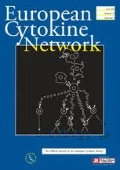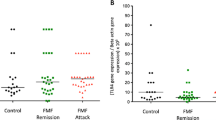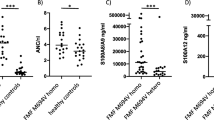Abstract
Objectives
Familial Mediterranean fever (FMF) is a recessively inherited autoinflammatory disorder. The caspase-1-dependent cytokine, IL-1β, plays an important role in FMF pathogenesis, and RAC1 protein has been recently involved in IL-1β secretion. This study aims to investigate RAC1 expression and role in IL-1β and caspase-1 production and oxidative stress generation in FMF.
Materials and methods
The study included 25 FMF patients (nine during attack and remission, and 16 during remission only), and 25 controls. RAC1 expression levels were analyzed by real-time PCR. Ex vivo production of caspase-1, IL-1β, IL-6 and markers of oxidative stress (malondialdehyde, catalase, and glutathione system) were evaluated respectively in supernatants of patients’ and controls’ PBMC and PMN cultures, in the presence and absence of RAC1 inhibitor.
Results
RAC1 gene expression and IL-1β levels were increased in patients in crises compared to those in remission or controls. RAC1 expression levels were correlated with MEFV genotypes, patients carrying the M694V/M694V genotype having a two-fold increase in the expression levels compared to those carrying other genotypes. Caspase-1 levels were higher in LPS-induced PBMC of patients in remission than controls. Spontaneous and LPS-induced IL-1β production were comparable in patients in remission and controls, whereas LPS-induced IL-6 production was enhanced in patients, compared to controls. RAC1 inhibition resulted in a decrease in caspase-1 and IL-1β, but not IL-6, levels. Malondialdehyde levels produced by LPS-stimulated PMNs were increased in patients in remission compared to those in controls, but decreased following RAC1 inhibition. Catalase and GSH activities were reduced in unstimulated PMN culture supernatants of patients in remission compared to controls and were increased in the presence of RAC1 inhibitor.
Conclusion
These results show the involvement of RAC1 in the inflammatory process of FMF by enhancing IL-1β production, through caspase-1 activation, and generating oxidative stress, even during asymptomatic periods.
Similar content being viewed by others
References
Sohar E, Gafni J, Pras M, Heller H. Familial Mediterranean fever. A survey of 470 cases and review of the literature. Am J Med 1967; 43: 227–53.
Medlej-Hashim M, Loiselet J, Lefranc G, Mégarbané A. Familial Mediterranean fever (FMF): from diagnosis to treatment. Santé 2004; 14: 261–6.
French FMF Consortium. A candidate gene for familial Mediterranean fever. Nat Genet 1997; 17: 25–31.
International FMF Consortium. Ancient missense mutations in a new member of the RoRet gene family are likely to cause familial Mediterranean fever. The International FMF Consortium. Cell 1997; 90: 797–807.
Centola M, Wood G, Frucht DM, et al. The gene for familial Mediterranean fever, MEFV, is expressed in early leukocyte development and is regulated in response to inflammatory mediators. Blood 2000; 95: 3223–31.
Papin S, Cuenin S, Agostini L, et al. The SPRY domain of pyrin, mutated in familial Mediterranean fever patients, interacts with inflammasome components and inhibits proIL-1β processing. Cell Death Differ 2007; 14: 1457–66.
Chae JJ, Wood G, Masters SL, et al. The B30. 2 domain of pyrin, the familial Mediterranean fever protein, interacts directly with caspase-1 to modulate IL-1β production. Proc Natl Acad Sci U S A 2006; 103: 9982–7.
Yu JW, Wu J, Zhang Z, et al. Cryopyrin and pyrin activate caspase-1, but not NF-κB, via ASC oligomerization. Cell Death Differ 2005; 13: 236–49.
Shamaa OR, Mitra S, Gavrilin MA, Wewers MD. Monocyte caspase-1 is released in a stable, active high molecular weight complex distinct from the unstable cell lysate-activated caspase-1. PLoS One 2015; 10: e0142203.
Lopez-Castejon G, Brough D. Understanding the mechanism of IL-1β secretion. Cytokine Growth Factor Rev 2011; 22: 189–95.
Dinarello CA. Interleukin-1 in the pathogenesis and treatment of inflammatory diseases. Blood 2011; 117: 3720–32.
Ibrahim J-N, Isabelle J, Lecron J-C, Medlej-Hashim M. Cytokine signatures in hereditary fever syndromes (HFS). Cytokine Growth Factor Rev 2016; S1359-6101:30103–4 (PubMed — NCBI).
Ibrahim J-N, Jounblat R, Delwail A, et al. Ex vivo PBMC cytokine profile in familial Mediterranean fever patients: involvement of IL-1β, IL-1α and Th17-associated cytokines and decrease of Th1 and Th2 cytokines. Cytokine 2014; 69: 248–54.
Normand S, Massonnet B, Delwail A, et al. Specific increase in caspase-1 activity and secretion of IL-1 family cytokines: a putative link between mevalonate kinase deficiency and inflammation. Eur Cytokine Netw 2009; 20: 101–7.
Kuijk LM, Beekman JM, Koster J, Waterham HR, Frenkel J, Coffer PJ. HMG-CoA reductase inhibition induces IL-1 release through Rac1/PI3K/PKB-dependent caspase-1 activation. Blood 2008; 112: 3563–73.
Eitel J, Meixenberger K, van Laak C, et al. Rac1 regulates the NLRP3 inflammasome which mediates IL-1beta production in Chlamydophila pneumoniae infected human mononuclear cells. PLoS One 2012; 7: e30379.
Heller H, Sohar E, Sherf L. Familial Mediterranean fever. AMA Arch Intern Med 1958; 102: 50–71.
Gastonguay A, Berg T, Hauser AD, Schuld N, Lorimer E, Williams CL. The role of Rac1 in the regulation of NF-kB activity, cell proliferation, and cell migration in non-small cell lung carcinoma. Cancer Biol Ther 2012; 13: 647–56.
Sanlioglu S, Williams CM, Samavati L, et al. Lipopolysaccharide induces Rac1-dependent reactive oxygen species formation and coordinates tumor necrosis factor-alpha secretion through IKK regulation of NF-kappa B. J Biol Chem 2001; 276: 30188–98.
Raz L, Zhang Q-G, Zhou C, et al. Role of Rac1 GTPase in NADPH oxidase activation and cognitive impairment following cerebral ischemia in the rat. PLoS One 2010; 5: e12606.
Patil S. Important role for Rac1 in regulating reactive oxygen species generation and pulmonary arterial smooth muscle cell growth. Am J Physiol Lung Cell Mol Physiol 2004; 287: L1314–22.
Dalbeth N, Lauterio TJ, Wolfe HR. Mechanism of action of colchicine in the treatment of gout. Clin Ther 2014; 36: 1465–79.
Barth BM, Stewart-Smeets S, Kuhn TB. Proinflammatory cytokines provoke oxidative damage to actin in neuronal cells mediated by Rac1 and NADPH oxidase. Mol Cell Neurosci 2009; 41: 274–85.
Muise AM, Walters T, Xu W, et al. Single nucleotide polymorphisms that increase expression of the guanosine triphosphatase RAC1 are associated with ulcerative colitis. Gastroenterology 2011; 141: 633–41.
Bourgine J, Garat A, Allorge D, et al. Evidence for a functional genetic polymorphism of the Rho-GTPase Rac1. Implication in azathioprine response? Pharmacogenet Genomics 2011; 21: 313–24.
Ibrahim J-N, Chouery E, Lecron J-C, Mégarbané A, Medlej-Hashim M. Study of the association of IL-1β and IL-1RA gene polymorphisms with occurrence and severity of Familial Mediterranean fever. Eur J Med Genet 2015; 58: 668–73.
Ediz L, Ozkol H, Tekeoglu I, Tuluce Y, Gulcu E, Koyuncu I. Increased oxidative stress in patients with familial Mediterranean fever during attack period. Afr Health Sci 2011; 11: 6–13.
Guzel S, Andican G, Seven A, et al. Acute phase response and oxidative stress status in familial Mediterranean fever (FMF). Mod Rheumatol 2011; 22: 431–7.
Michel F, Bonnefont-Rousselot D, Mas E, Drai J, Thérond P. Biomarqueurs de la peroxydation lipidique: aspects analytiques. Ann Biol Clin (Paris) 2008: 605–20.
Deshpande SS. Constitutive activation of rac1 results in mitochondrial oxidative stress and induces premature endothelial cell senescence. Arterioscler Thromb Vasc Biol 2002; 23: 1e–6.
Khanday FA, Yamamori T, Mattagajasingh I, et al. Rac1 leads to phosphorylation-dependent increase in stability of the p66shc adaptor protein: role in Rac1-induced oxidative stress. Mol Biol Cell 2006; 17: 122–9.
Ozen S, Uckan D, Baskin E, et al. Increased neutrophil apoptosis during attacks of familial Mediterranean fever. Clin Exp Rheumatol 2001; 19: S68–71.
Spolarics Z, Wu J-X. Role of glutathione and catalase in H2O2 detoxification in LPS-activated hepatic endothelial and Kupffer cells. Am J Physiol 1997; 273: G1304–11.
Author information
Authors and Affiliations
Corresponding author
About this article
Cite this article
Ibrahim, JN., Jounblat, R., Jalkh, N. et al. RAC1 expression and role in IL-1β production and oxidative stress generation in familial Mediterranean fever (FMF) patients. Eur Cytokine Netw 29, 127–135 (2018). https://doi.org/10.1684/ecn.2018.0416
Accepted:
Published:
Issue Date:
DOI: https://doi.org/10.1684/ecn.2018.0416




